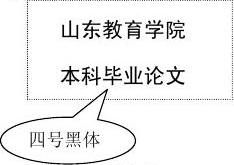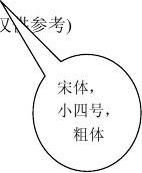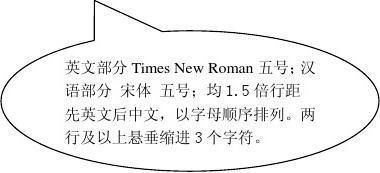纯英语毕业论文范文
The Use of Linking Adverbials by Chinese
College English Learners
A Thesis Submitted
to Faculty of International Studies of
Henan Normal University
in Partial Fulfillment of the Requirements
for the Degree of Bachelor of Arts
By
Liu Hiatao
Supervisor:Li Qingdong
May 5, 2008
Acknowledgement
I would like to thank all those who have given me their generous helps, commitment and enthusiasm, which have been the major driving force to complete the current paper. …
I
Abstract
The aim of this research is, through a general comparison between learners’ corpora and NSs’ corpora, to probe into the characteristics of Chinese EFL learners with regard to their use of linking adverbials in writing and speaking, and give an impersonal description about the non-nativeness that the learners demonstrate in the use of linking adverbials. It is found that Chinese EFL learners have shown an overall overusing tendency in using linking adverbials in their speaking and writing. The results have shown that the factors which contributing to Chinese EFL learners’ use of linking adverbials are multifold, such as mother tongue transfer, pedagogical instructions, stylistic awareness, semantic understanding, and pragmatic considerations. Key Words: Linking Adverbials; Chinese EFL learners; Use; Teaching
II
Table of Contents
Acknowledgement. . . . . . . . . . . . . . . . . . . . . . . . . . . . . . . . . . . . . . . . . . . . . . . . . . . . . . . . . . . . . . .I 摘要. . . . . . . . . . . . . . . . . . . . . . . . . . . . . . . . . . . . . . . . . . . . . . . . . . . . . . . . . . . . . . . . . . . . . . . . .. II Abstract. . . . . . . . . . . . . . . . . . . . . . . . . . . . . . . . . . . . . . . . . . . . . . . . . . . . . . . . . . . . . . . . . . . . . ..III Table of Contents. . . . . . . . . . . . . . . . . . . . . . . . . . . . . . . . . . . . . . . . . . . . . . . . . . . . . . . . . . . . . .. IV Chapter One Introduction. . . . . . . . . . . . . . . . . . . . . . . . . . . . . . . . . . . . . . . . . . . . . . .1
1.1 Research Background. . . . . . . . . . . . . . . . . . . . . . . . . . . . . . . . . . . . . . . . . . .1
1.2 Motivations and Objectives. . . . . . . . . . . . . . . . . . . . . . . . . . . . . . . . . . . . . . .2 Chapter Two The Theoretical Framework of Child Language Learning. . . . . . . . . . . 5
2.1 Introduction. . . . . . . . . . . . . . . . . . . . . . . . . . . . . . . . . . . . . . . . . . . . . . . . . . 5
2.2 A Selective Review of Child Learning. . . . . . . . . . . . . . . . . . . . . . . . . . . . . .5
2.3 Child Language Learning. . . . . . . . . . . . . . . . . . . . . . . . . . . . . . . . . . . . . . 13
2.3.1 Child First Language Development. . . . . . . . . . . . . . . . . . . . . . . . . . . 14
2.3.2 Child Second Language Development. . . . . . . . . . . . . . . . . . . . . . . . 16
2.3.3 Child Foreign Language Learning. . . . . . . . . . . . . . . . . . . . . . . . . . . . 19
2.4 Summary of Key Learning Principles. . . . . . . . . . . . . . . . . . . . . . . . . . . . . 23 Chapter Three Some Critical Issues in Primary EFL Instruction in Chinese Context. . . . . . . . . . .25
3.1 Introduction. . . . . . . . . . . . . . . . . . . . . . . . . . . . . . . . . . . . . . . . . . . . . . . . . 25
3.2 The Debate about the Inclusion of English in the Primary Curriculum. . . .25
3.3 The Contents of Primary English Curriculum. . . . . . . . . . . . . . . . . . . . . . . 27
3.4 Approaches to Primary Instruction. . . . . . . . . . . . . . . . . . . . . . . . . . . . . . . .30
3.5 Assessment in Primary English Curriculum. . . . . . . . . . . . . . . . . . . . . . . . 34 Chapter Four Research Design – A Survey Study. . . . . . . . . . . . . . . . . . . . . . . . . . . .37
4.1 Introduction. . . . . . . . . . . . . . . . . . . . . . . . . . . . . . . . . . . . . . . . . . . . . . . . .37
4.2 The Survey Background. . . . . . . . . . . . . . . . . . . . . . . . . . . . . . . . . . . . . . . .37
4.3 Subjects. . . . . . . . . . . . . . . . . . . . . . . . . . . . . . . . . . . . . . . . . . . . . . . . . . . . 37
4.5 Data Collection and Analysis. . . . . . . . . . . . . . . . . . . . . . . . . . . . . . . . . . . .43 Chapter Five Results and Discussions. . . . . . . . . . . . . . . . . . . . . . . . . . . . . . . . . . . . .45
5.1 Introduction. . . . . . . . . . . . . . . . . . . . . . . . . . . . . . . . . . . . . . . . . . . . . . . . .45 III
5.2 The Overview of Primary EFL Program in Henan Province. . . . . . . . . . . .45
5.3 The Current Situation of Primary English Classroom Instruction. . . . . . . .52 Chapter Six Conclusion . . . . . . . . . . . . . . . . . . . . . . . . . . . . . . . . . . . . . . . . . . . . . . .69
6.1 Major Findings and Contributions. . . . . . . . . . . . . . . . . . . . . . . . . . . . . . . .69
6.2 Recommendations for Future Research. . . . . . . . . . . . . . . . . . . . . . . . . . . .71 Appendixes. . . . . . . . . . . . . . . . . . . . . . . . . . . . . . . . . . . . . . . . . . . . . . . . . . . . . . . . . .73 Bibliography. . . . . . . . . . . . . . . . . . . . . . . . . . . . . . . . . . . . . . . . . . . . . . . . . . . . . . . . . . . . . . . . . . .82
IV
河南师范大学本科毕业论文
Chapter One Introduction
1.1 Research Background
In the first decade1 or two after World War II, the introduction of foreign languages in the elementary school in the U.S.A.1, and of primary school French in Britain, and similar developments in other countries were part of a widespread search for ways of “improving the effectiveness of language education by taking into account into timetable of language development in childhood” (Stern, 1983, 363). The past decade has seen significant increase in foreign language programs for young learners. In many African and Asian countries, primary children have long been taught French or English as preparation for their use as a medium of instruction.
1.2 Motivations and Objectives
1 U.S.A. is the abbreviation of The United States of America.
1
河南师范大学本科毕业论文
Bibliography
Altenberg, B. (1984). Causal Linking in Spoken and Written English. Studia Linguistica, 38 (pp. 20-69).
Halliday, M. A. K., & Husan, R. (1988). An Introduction to Functional Grammar: Edward
Arnorld.
Halliday, M. A. K., & Husan, R. (1970). Language Structure and Language Function. In Lyons
(Ed.), Peguin Books (pp. 221-224).
Hatch, E. (1992). Discourse and Language Education. London: Cambridge University Press. Quirk, R. et al (1972). A Grammar of Contemporary English. London: Longman.
罗瑞球. (2002). 英语习语翻译教学. 湖南师范大学教育科学学报(3).
徐其画 & 王乃文. (1989). 实用英译汉教程. 上海: 上海外语教育出版社.
杨慧中(主编). (2002).语料库语言学导论. 上海:上海外语教育出版社。
冯庆华. (2002). 实用翻译教程. 上海: 上海外语教育出版社.
张培基等. (1983). 英汉翻译教程. 上海: 上海外语教育出版社.
2
第二篇:Cyaehdn纯英语毕业论文范文
Time will pierce the surface or youth, will be on the beauty of the ditch dug a shallow groove ; Jane will eat rare!A born beauty, anything to escape his sickle sweep
.-- Shakespeare
外国语学院本科生英语专业毕业论文装订顺序(APA格式)
(注:此格式用于文学、翻译方向之外的所有论文)
1. 毕业论文封面(汉语)
2. 毕业论文首页 (英语)
3. 致谢(英文)
4. 毕业论文中文摘要及关键词
5. 毕业论文英文摘要及关键词
6. 目录
7. 正文
8. 尾注(可选)
9. 参考文献(英语文献在前,汉语文献在后)
10. 附录(可选)
附:论文模板(模板内容仅供参考,毕业生可根据实际情况填写)



学号:
使用情况调查
系 名 称: 外 语 系 专 业 名 称: 年 级: 姓 名: 指 导 教 师:
2008 年 5 月 日
The Use of Linking Adverbials by Chinese
College English Learners
A Thesis Submitted
to Faculty of International Studies of
Henan Normal University
in Partial Fulfillment of the Requirements
for the Degree of Bachelor of Arts
By
Liu Hiatao
Supervisor:Li Qingdong
May 5, 2008



enthusiasm, which have been the major driving force to complete the current paper. ?


无论在口语还是在写作中,中国大学英语学习者在连接副词的使用上都有过

多使用的倾向。影响中国大学英语学习者使用连接副词的因素是多方面的,如母
(


linking adverbials in writing and speaking, and give an impersonal description about the non-nativeness that the learners demonstrate in the use of linking adverbials. It is found that Chinese EFL learners have shown an overall overusing tendency in using linking adverbials in their speaking and writing. The results have shown that the factors which contributing to Chinese EFL learners’ use of linking adverbials are multifold, such as mother tongue transfer, pedagogical instructions, stylistic awareness, semantic understanding, pragmatic considerations.
Times New Roman
五号 粗体


Acknowledgement. . . . . . . . . . . . . . . . . . . . . . . . . . . . . . . . . . . . . . . . . . . . . . . . . . . . . . . . . . . . . . .I

. . . . . . . . . . . . . . . . . . . . . . . . . . . . . . . . . . . . . . . . . . . . . . . . . . . . . . . . . . . . . . . . . . . . . . . . .. II Chapter One Introduction. . . . . . . . . . . . . . . . . . . . . . . . . . . . . . . . . . . . . . . . . . . . . . .1
1.1 Research Background. . . . . . . . . . . . . . . . . . . . . . . . . . . . . . . . . . . . . . . . . . .1
1.2 Motivations and Objectives. . . . . . . . . . . . . . . . . . . . . . . . . . . . . . . . . . . . . . .2 Two The Theoretical Framework of Child Language Learning. . . . . . . . . . . 5
2.1 Introduction. . . . . . . . . . . . . . . . . . . . . . . . . . . . . . . . . . . . . . . . . . . . . . . . . . 5
2.2 A Selective Review of Child Learning. . . . . . . . . . . . . . . . . . . . . . . . . . . . . .5 2.3 Child Language Learning. . . . . . . . . . . . . . . . . . . . . . . . . . . . . . . . . . . . . . 13
2.3.1 Child First Language Development. . . . . . . . . . . . . . . . . . . . . . . . . . . 14
2.3.2 Child Second Language Development. . . . . . . . . . . . . . . . . . . . . . . . 16
2.3.3 Child Foreign Language Learning. . . . . . . . . . . . . . . . . . . . . . . . . . . . 19
2.4 Summary of Key Learning Principles. . . . . . . . . . . . . . . . . . . . . . . . . . . . . 23 Chapter Three Some Critical Issues in Primary EFL Instruction in Chinese Context. . . . . . . . . . .25
3.1 Introduction. . . . . . . . . . . . . . . . . . . . . . . . . . . . . . . . . . . . . . . . . . . . . . . . . 25
3.2 The Debate about the Inclusion of English in the Primary Curriculum. . . .25
3.3 The Contents of Primary English Curriculum. . . . . . . . . . . . . . . . . . . . . . . 27
3.4 Approaches to Primary Instruction. . . . . . . . . . . . . . . . . . . . . . . . . . . . . . . .30
3.5 Assessment in Primary English Curriculum. . . . . . . . . . . . . . . . . . . . . . . . 34 Chapter Four Research Design – A Survey Study. . . . . . . . . . . . . . . . . . . . . . . . . . . .37
4.1 Introduction. . . . . . . . . . . . . . . . . . . . . . . . . . . . . . . . . . . . . . . . . . . . . . . . .37
4.2 The Survey Background. . . . . . . . . . . . . . . . . . . . . . . . . . . . . . . . . . . . . . . .37
4.3 Subjects. . . . . . . . . . . . . . . . . . . . . . . . . . . . . . . . . . . . . . . . . . . . . . . . . . . . 37
4.5 Data Collection and Analysis. . . . . . . . . . . . . . . . . . . . . . . . . . . . . . . . . . . .43 Chapter Five Results and Discussions. . . . . . . . . . . . . . . . . . . . . . . . . . . . . . . . . . . . .45
5.1 Introduction. . . . . . . . . . . . . . . . . . . . . . . . . . . . . . . . . . . . . . . . . . . . . . . . .45
5.2 The Overview of Primary EFL Program in Henan Province. . . . . . . . . . . .45
5.3 The Current Situation of Primary English Classroom Instruction. . . . . . . .52 Chapter Six Conclusion. . . . . . . . . . . . . . . . . . . . . . . . . . . . . . . . . . . . . . . . . . . . . . .69
6.1 Major Findings and Contributions. . . . . . . . . . . . . . . . . . . . . . . . . . . . . . . .69
6.2 Recommendations for Future Research. . . . . . . . . . . . . . . . . . . . . . . . . . . .71 Appendixes. . . . . . . . . . . . . . . . . . . . . . . . . . . . . . . . . . . . . . . . . . . . . . . . . . . . . . . . . .73 Bibliography. . . . . . . . . . . . . . . . . . . . . . . . . . . . . . . . . . . . . . . . . . . . . . . . . . . . . . . . . . . . . . . . . . .82

全文每段首行缩
Times New
Roman, 小
四号,粗体 进3-5个字符 Times New Roman 三号,粗体,居中 1school in the U.S.A.1, and of primary school French in Britain, and similar developments in other countries were part of a widespread search for ways of “improving the
effectiveness of language education by taking into account into timetable of language development in childhood” (Stern, 1983, 363). The past decade has seen significant increase in foreign language programs for young learners. In many African and Asian countries, primary children have long been taught French or English as for their use as a medium of instruction.
Times New Roman
1.2 Motivations and Objectives 五号,1.5倍行距


2.


Altenberg, B. (1984). Causal Linking in Spoken and Written English. Studia Linguistica, 38 (pp. 20-69).
Halliday, M. A. K., & Husan, R. (1988). An Introduction to Functional Grammar: Edward
Arnorld.
Halliday, M. A. K., & Husan, R. (1970). Language Structure and Language Function. In Lyons
(Ed.), Peguin Books (pp. 221-224).
Hatch, E. (1992). Discourse and Language Education. London: Cambridge University Press. Quirk, R. et al (1972). A Grammar of Contemporary English. London: Longman.
罗瑞球. (2002). 英语习语翻译教学. 湖南师范大学教育科学学报(3).
徐其画 & 王乃文. (1989). 实用英译汉教程. 上海: 上海外语教育出版社.
杨慧中(主编). (2002).语料库语言学导论. 上海:上海外语教育出版社。
冯庆华. (2002). 实用翻译教程. 上海: 上海外语教育出版社.
张培基等
(以上格式分别为“期刊文章”、“两位作者”、“编集著作”、“单一作者”、“多个作者”等的英文书目格式,及“期刊文章”、“两位作者”、“编集著作”、“单一作者”、“多个作者”等的中文书目格式)
封底
(此部分不编入页码,且不写入任何内容)
-
英语毕业论文开题报告
中国儿童英语词汇教学学生:王宇平指导老师:林玲教学单位:三峡大学外国语学院1,课题来源中国儿童英语词汇教学的提出是培养21世纪新型…
-
英语毕业论文答辩问题小结
1.选题原因:由于我自己对经济方面比较感兴趣,而且特别喜欢IBM,所以就想写关于此方面的论文,但因为自己不是经济专业学生所以对经济…
-
(英语毕业论文)浅析葛浩文在翻译莫言《酒国》结尾时对原文的删改
最新英语专业全英原创毕业论文,都是近期写作12345678910111213141516171819202122232425262…
-
商务英语毕业论文题目与范文参考
商务英语论文题目|商务英语毕业论文题目参考一、英语论文基本格式1、毕业论文结构包括:主标题、论文摘要、正文(一般不少于5000字)…
-
(英语毕业论文)从《生活大爆炸》中看中西幽默的差异
最新英语专业全英原创毕业论文,都是近期写作1AnanalysisofAmericanRacismandBlackTradition…
-
英语本科毕业论文优秀范文
大学毕业设计(论文)题目:AnalysisofthecontextualmeaningofEnglishWord作者:层次:本科专…
-
本科毕业论文英文题目及英文摘要撰写指导
本科毕业论文英文题目及英文摘要撰写指导毕业论文是本科生对大学所学知识的总结性作业又是申请学士学位的前提和依据在系统介绍学术论文的英…
-
英语专业毕业论文范文1
关于论文结构和格式规范的有关问题请认真阅读外国语学院英语本科毕业论文撰写要求同时可查阅MLA格式学位论文写作规范供查询用建议以本范…
-
英语专业毕业论文开题报告的写法、论点和论句
在正式撰写毕业之前学生要写出以便指导老师能根据学生对文献的综述和对所选论题的认识确定其可行性开题报告是作者将自己初步选定的题目之内…
-
英语专业毕业论文范文1
关于论文结构和格式规范的有关问题请认真阅读外国语学院英语本科毕业论文撰写要求同时可查阅MLA格式学位论文写作规范供查询用建议以本范…
-
高等教育自学考试英语专业本科毕业论文撰写说明
高等教育自学考试英语专业本科毕业论文撰写说明一论文撰写的步骤与方法本科论文的写作一般由选题文献检索与资料整理撰写提纲起草论文教师批…